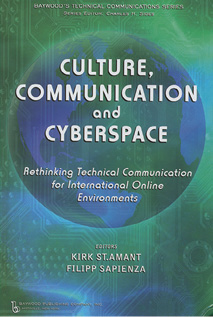My Articles & Presentations
Professional Development
Resume
Services I Provide
Testimonials
How I Work
New Clients
Disaster Preparedness
Culture, Communication and Cyberspace: Rethinking Technical Communication for International Online Environments
Originally published in Technical Communication, Vol. 59, No. 3
Kirk St.Amant and Filipp Sapienza, Eds. 2011. Amityville, NY: Baywood Publishing Company, Inc. [ISBN 978-0-89503-398-7. 258 pages, including index. $54.95 USD.]
 Culture, Communication and
Cyberspace is a collection of
ten scholarly essays divided
into three sections:
theoretical approaches to
online technical
communication, online
cross-cultural interactions,
and cross-cultural
collaborations, especially in
an educational context.
Contributors include STC award winners, university professors in the US and
Taiwan, and PhD students. Because of the contributions
from Taiwan universities, most of the research presented
involves interactions with Asia, in particular China. The
exception is one experiment in Kenya for developing
better AIDS prevention materials.
Culture, Communication and
Cyberspace is a collection of
ten scholarly essays divided
into three sections:
theoretical approaches to
online technical
communication, online
cross-cultural interactions,
and cross-cultural
collaborations, especially in
an educational context.
Contributors include STC award winners, university professors in the US and
Taiwan, and PhD students. Because of the contributions
from Taiwan universities, most of the research presented
involves interactions with Asia, in particular China. The
exception is one experiment in Kenya for developing
better AIDS prevention materials.
Having graduated college a while ago, I found myself back in study mode, annotating sections as if I had to write a class paper. Students are also likely the intended audience for this book. For them, there is lots of interesting information and suggestions on where further research is needed, potentially topics for readers' dissertations. Others parties will find intriguing nuggets of information, such as “The average information system user, in English-speaking locales, spends fewer than 10 seconds browsing the results of a retrieval algorithm” (p. 75) It would be interesting to see such a statistic for other languages. Do people from other cultures spend more time looking at search results before moving on? Are there differences in attention span between different English-speaking locales, such as South Africa and Canada?
Not surprisingly, Culture, Communication and Cyberspace is less useful for practicing technical communicators. Few chapters offer advice on real-world application of the research presented, although awareness of the issues studied — such as the way in which cultural factors affect online communication between Asian and North American writers — is certainly helpful. After all, even if our colleagues elsewhere in the world communicate with us in English, or our international readers peruse an English-language Web site, they still apply their own cultural assumptions to those activities. Knowing that fact may help US-based technical communicators design Web sites and help systems that are better adapted to such cultural differences.
However, I am not sure that this awareness couldn't also be gained from reading a couple of online articles, rather than an entire book of academic essays. So if you are a student or an educator, or are simply interested in the theory of international communication, this may be a good read for you. But if you are looking for practical advice on designing an international Web site or communicating with your international team, you may be better served by more practice-oriented publications.
Barbara Jungwirth
After majoring in Media Studies, Barbara managed an IT
department and wrote software documentation. She now translates technical, legal and business documents from German
into English for her own company, reliable translations llc
(www.reliable-translations.com). Barbara also writes a blog, On
Language and Translation (http://reliable-translations.blogspot.com/), and tweets (@reliabletran).